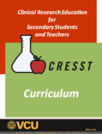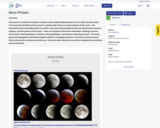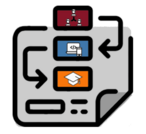
This is the fourth part of the Clinical Researcg Education for Secondary Students and Teachers.
- Subject:
- Research
- Material Type:
- Lesson Plan
- Author:
- Dr. Lisa Abrams
- Date Added:
- 09/04/2023

This is the fourth part of the Clinical Researcg Education for Secondary Students and Teachers.

This lesson is created to introduce students to the relationship between the sun, Earth, and the moon. The movement of Earth and the moon in relationship to the sun causes phases of the moon. The interactions and orientation of the sun, Earth, and moon lead to patterns that are evidenced in seasons, eclipses, and the phases of the moon. There are 8 phases of the moon: New Moon, Waxing Crescent, First Quarter, Waxing Gibbous, Full Moon, Waning Gibbous, Last Quarter, Waning Crescent. The moon grows and disappears backwards (right to left)in its changing of phases. The moon revolves around Earth as the Earth revolves around the sun. The moon takes about one month to complete one revolution around the Earth.

Students are asked to shade in the graphics to illustrate understanding of the moon's phases, then to cut out the cards as a means to study the characteristics of each phase.

Video Description: What causes the phases of the Moon? From New Moon to Full Moon, the Earth-Sun-Moon system is responsible for the Moon’s changing phases. Learn more about rotation, revolution and this repeatable pattern. Video Length: 3:13. NASA eClipsTM is a suite of online student-centered, standards-based resources that support instruction by increasing STEM literacy in formal and nonformal settings. These free digital and downloadable resources inform and engage students through NASA-inspired, real-world connections.NASA eClips Our World videos (grades 3-5) help students understand the differences between science (the natural world) and engineering (the designed world). These video segments supplement elementary learning objectives not only in science, technology, engineering and mathematics, but also in reading, writing, visual and performing arts.

In this lesson students will be able to identify that computers, like the solar system, complete predictable actions based on a set of variables. Students will learn about the solar system via Scratch. They will explore block coding and computational thinking practices as they utilize Scratch as a tool for creativity, expression and learning about the Solar System.